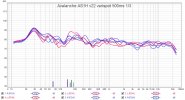Back to the original question. In another thread, I compared Revel floor speakers to stand speakers that used the same drivers and design choices. The difference was that the floor speakers had twice as many bass drivers. In measured performance, the difference was in linearity--really reciprocity--does 3 dB more power draw result in 3 dB more SPL? Answer: yes, to a higher SPL with the floor speakers versus the stand speakers, particularly in the 80-200 band (the stand speakers had no pretensions much lower than that).
One person argued with me because he has his subs crossed over at 120 Hz. But I doubt most would do that, and crossing it very high will allow it to call attention to itself.
So, it seems to me that we can determine from measurements that speakers with more low-driver surface area will produce higher SPL in the region just above the subs than speakers with less low-driver surface area. Yes, this might be overcome by design--using drivers with greater excursion in the smaller speaker. But given similar design, I think it's a good rule of thumb.
My Revel F12's were particularly good at sustaining that reciprocity in the tests that Soundstage conducted in the NRC labs. They have two 8" drivers--the rough equivalent of a single 12" driver--plus a mid-range driver for a true 3-way design. I would not want to give up what those can do even if I added subs. And, as Don suggests, adding subs would probably help them do it better.
I would not cross the subs any higher than 60 Hz, and they would still be good for filling in nulls probably up into the 90's, but only if I have complete freedom to move them around (which in my room is a bit of a fantasy for non-audio reasons). My mains would still be doing their thing down to 40 Hz at least. I can use my PEQ to high-pass filter the mains, and whatever subs I buy will have low-pass filters in their plate amps.
I do not watch movies on that system.
Rick "one can always turn it down" Denney

